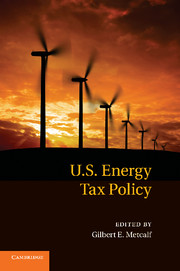Book contents
- Frontmatter
- Contents
- Conference Participants
- 1 Introduction
- 2 Distributional Impacts of Carbon Pricing Policies in the Electricity Sector
- 3 Distributional Impacts of a U.S. Greenhouse Gas Policy
- 4 Instrument Choice Is Instrument Design
- 5 Taxes, Permits, and Climate Change
- 6 Border Adjustments for Carbon Taxes and the Cost of Emissions Permits
- 7 Taxes and Caps as Climate Policy Instruments with Domestic and Imported Fuels
- 8 How Much Should Highway Fuels Be Taxed?
- 9 State Tax Policy and Oil Production
- 10 The Social Costs and Benefits of U.S. Biofuel Policies with Preexisting Distortions
- Index
- References
4 - Instrument Choice Is Instrument Design
Published online by Cambridge University Press: 01 June 2011
- Frontmatter
- Contents
- Conference Participants
- 1 Introduction
- 2 Distributional Impacts of Carbon Pricing Policies in the Electricity Sector
- 3 Distributional Impacts of a U.S. Greenhouse Gas Policy
- 4 Instrument Choice Is Instrument Design
- 5 Taxes, Permits, and Climate Change
- 6 Border Adjustments for Carbon Taxes and the Cost of Emissions Permits
- 7 Taxes and Caps as Climate Policy Instruments with Domestic and Imported Fuels
- 8 How Much Should Highway Fuels Be Taxed?
- 9 State Tax Policy and Oil Production
- 10 The Social Costs and Benefits of U.S. Biofuel Policies with Preexisting Distortions
- Index
- References
Summary
This chapter analyzes the choice between taxes and cap-and-trade systems as methods of controlling greenhouse gas emissions. It argues that within a single country, commonly discussed differences between the two instruments are due to unjustified assumptions about design. In the climate change context and within a single country there is sufficient design flexibility that these differences can be substantially eliminated. To the extent that there are remaining differences, there should be a modest preference for taxes, but the benefits of taxes are swamped by the benefits of good design; even though the very best tax might be better than the very best quantity restriction, the first order of business is getting the design right.
In the international context, however, taxes dominate more strongly. The design flexibility available within a single country is reduced in the international context because of the problems of coordinating systems across countries and minimizing holdouts. Moreover, the incentives to cheat and the effects of cheating are not equivalent for the two instruments in the international setting. Because climate change will require a global system for emissions, these considerations mean we should favor taxes for controlling greenhouse gas emissions. Nevertheless, the preference should be modest; substantial flexibility remains even internationally, and taxes also have coordination and enforcement problems.
Section 4.1 provides basic definitions. Section 4.2 considers the arguments attributed to Weitzman (1974) that taxes and permit systems are different when the government is uncertain about the marginal costs of abatement.
- Type
- Chapter
- Information
- US Energy Tax Policy , pp. 113 - 158Publisher: Cambridge University PressPrint publication year: 2010
References
- 11
- Cited by



